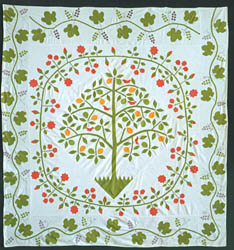Art of the Needle: Masterpiece Quilts on view at the National Heritage Museum – The Journal of Antiques and Collectibles – June 2007
Art of the Needle: Masterpiece Quilts from the Shelburne Museum is an exquisite display drawn from one of the richest and most diverse quilt collections in the country. The exhibition, on view at the National Heritage Museum from May 26 through September 9, 2007, will feature 35 antique quilts, most gathered by pioneering collector and founder of the Shelburne Museum, Electra Havemeyer Webb. Wholecloth, pieced and appliquéd examples from New England and other parts of the United States will be on display. The exhibition is a special opportunity to see and enjoy quilts and textiles from a collection internationally known for its exceptional depth, range and quality.
“Art of the Needle” presents quilts representing a wide variety of construction or design themes that have been popular at different times: album, Amish, appliqué, chintz appliqué, pieced, Victorian (crazy and log cabin), and wholecloth. Taken together they embody an extraordinary range of artistic impulses – from the exacting precision of stitching in pieced quilts to the exhilarating color and chaos of crazy quilts.
Album
Album quilts, comprised of distinct appliquéd blocks, may feature intricate floral designs or depict narrative scenes that lend a rich pictorial quality to the quilt. The Major Ringgold Album quilt is an excellent example of the elaborate sewing details, expensive fabrics, and variety of patterns used in Baltimore-style album quilts.
Amish
Characterized by bright colors and simple geometric shapes, Amish quilts are dramatically different in style from ornate designs popular in late Victorian America. Black is often the background of choice for Amish quilts, both to contrast with the bright colors used and to recycle fabric left over from making clothing. Concentric Squares, made in 1900 in Lancaster, Pennsylvania, is a superb example of pieced square combinations frequently found in Amish quilts.
Appliqué
Appliqué quilts, which allow the maker great flexibility in creating designs, have been made since the early 19th century. Hannah E. Hamblin Delano, the quilter who fashioned the Tree of Life Medallion Pattern quilt, adopted a folk art style to depict the tree of life motif, an ancient Indian textile design initially borrowed by Europeans in the late 16th century.
Chintz Appliqué
Chintz refers to fantastical flower-printed cottons, often glazed to a shine. “The Art of the Needle” presents the superb Flowers and Fruit Basket, made in about 1830 by Martha Custis Peter, a granddaughter of Martha Custis Washington, George Washington’s wife.
Pieced
Pieced quilts date to 18th-century America and offer the quilter a flexible technique. The exhibition includes a number of stunning geometric designs, including the intricate Pyrotechnic Star quilt
Victorian, Crazy and Log Cabin
Crazy and log cabin quilts are well represented in “Art of the Needle.” The log cabin pattern typically contrasts areas of light and dark cloth to dramatically emphasize geometric shapes. A popular enthusiasm for Chinese and Japanese imagery in the 1870s spawned the thrilling “crazy” patchwork technique, in which irregularly shaped pieces are sewn together in a seemingly random fashion and then embellished with embroidery, ribbons, or hand-painted scenes.
Wholecloth
The wholecloth quilts usually were made using high-quality, richly colored solid glazed wool, on which elaborate patterns and designs were stitched. The back of the quilt would often be a lesser quality wool, such as a blanket. The Pheasant and Mandarin Duck Motif Wholecloth quilt, made by Susannah Rebecca Woolley of Long Island, New York is a marvelous example of this technique.
The National Heritage Museum is dedicated to presenting exhibitions and programs on a wide variety of topics in American history and popular culture. The National Heritage Museum is located at 33 Marrett Road in Lexington, at the corner of Route 2A and Massachusetts Avenue. Hours are Monday through Saturday from 10 a.m. to 5 p.m., and Sunday, noon to 5 p.m. Admission and parking are free. Heritage Shop and Courtyard Café on site. For further information contact the museum at (781) 861-6559 or visit www.nationalheritagemuseum.org.
[amazon_carousel widget_type=”SearchAndAdd” width=”550″ height=”200″ title=”More on quilts:” market_place=”US” shuffle_products=”False” show_border=”False” keywords=”Quilt collecting” browse_node=”” search_index=”Books” /]





Related posts: